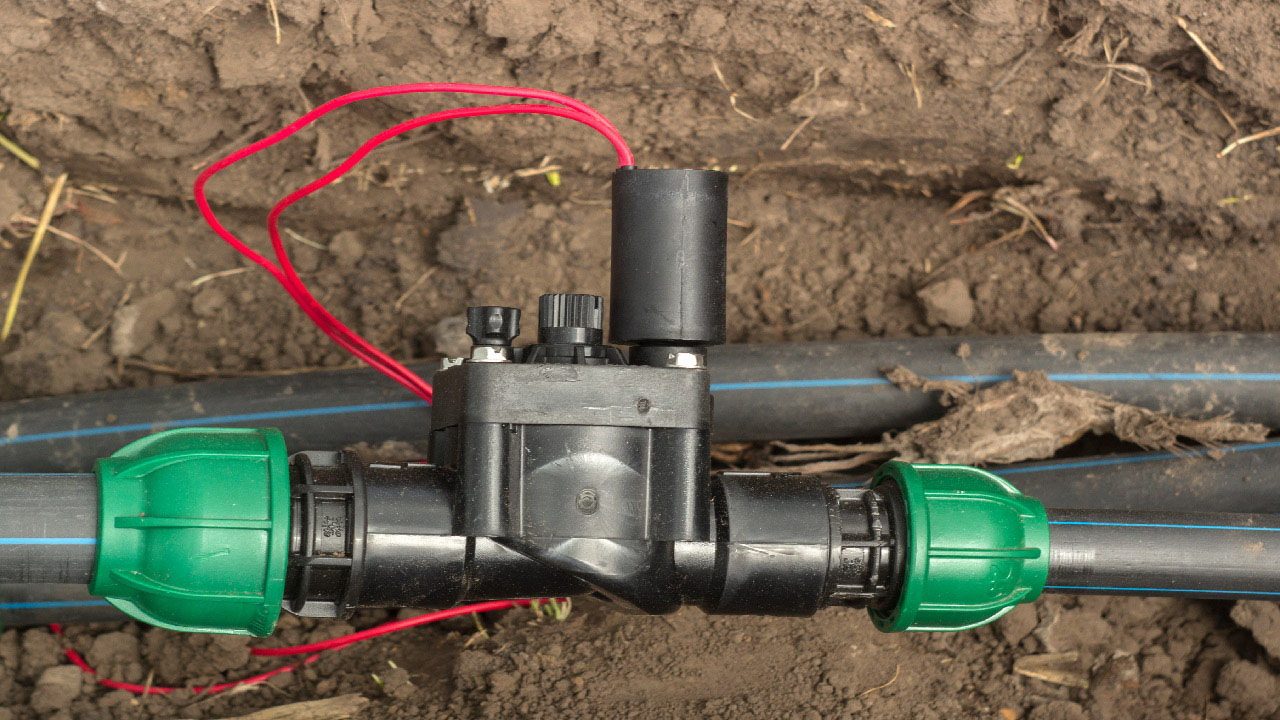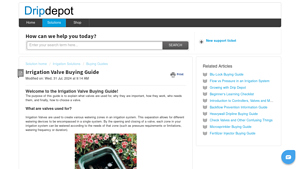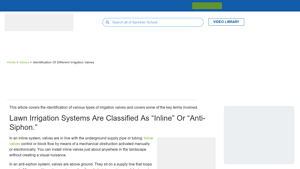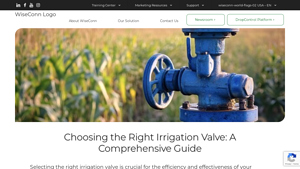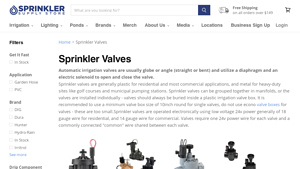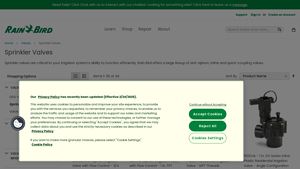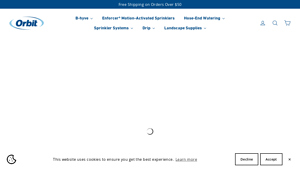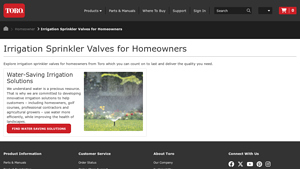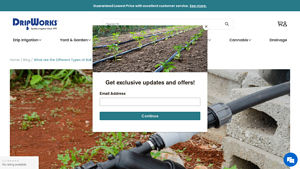Introduction: Navigating the Global Market for irrigation valve types
In the ever-evolving landscape of agricultural practices, sourcing the right irrigation valve types can be a daunting challenge for international B2B buyers. As global demand for efficient water management increases, understanding the nuances of various valve types is crucial for optimizing irrigation systems and ensuring sustainable agricultural practices. This guide serves as a comprehensive resource, detailing the different types of irrigation valves, their specific applications, and essential factors to consider during the procurement process, including supplier vetting and cost implications.
International buyers from regions such as Africa, South America, the Middle East, and Europe—particularly countries like Germany and Nigeria—will find valuable insights tailored to their unique market needs. This guide not only demystifies complex terminology and technology but also highlights key considerations such as material durability, compatibility with existing systems, and the importance of zoning for efficient water distribution. By equipping decision-makers with actionable information, this resource empowers businesses to make informed purchasing decisions that enhance operational efficiency and promote responsible resource management.
Navigating the global market for irrigation valves has never been more critical, and this guide is your key to unlocking the potential for improved agricultural productivity and water conservation.
Understanding irrigation valve types Types and Variations
| Type Name | Key Distinguishing Features | Primary B2B Applications | Brief Pros & Cons for Buyers |
|---|---|---|---|
| Gate Valves | Full flow control; robust materials | Large agricultural systems, commercial landscaping | Pros: High durability, unobstructed flow; Cons: Slower operation, requires more space. |
| Ball Valves | Quick operation with a spherical disc | Residential irrigation, industrial applications | Pros: Fast operation, leak-proof; Cons: Limited flow regulation, may require frequent adjustments. |
| Butterfly Valves | Compact design with a rotating disc | Municipal water systems, commercial irrigation | Pros: Space-saving, cost-effective; Cons: May have higher pressure loss compared to other types. |
| Solenoid Valves | Electrically operated for automation | Automated irrigation systems, smart agriculture | Pros: Efficient zone control, easy automation; Cons: Dependence on electrical systems, potential for solenoid failure. |
| Anti-Siphon Valves | Prevent backflow; integrated design | Residential gardens, small-scale farms | Pros: Ensures water safety, easy installation; Cons: Limited flow capacity, may be more expensive. |
What Are the Characteristics and Suitability of Gate Valves for B2B Buyers?
Gate valves are designed for maximum flow control, making them suitable for large irrigation systems where high water distribution is critical. Typically constructed from durable materials like brass or stainless steel, they offer longevity and reliability in demanding environments. B2B buyers should consider the valve’s size and flow capacity, as well as installation space, since gate valves may require more room compared to other types. Their slower operation may also necessitate careful planning in systems where rapid adjustments are needed.
How Do Ball Valves Benefit B2B Applications?
Ball valves are favored in various B2B applications due to their quick operation and minimal pressure drop. Their design features a spherical disc that allows for rapid opening and closing, which is crucial for systems that require frequent adjustments, such as residential irrigation or industrial applications. Buyers should evaluate the sealing mechanisms to ensure leak-proof operation, as this can significantly reduce water waste. While they are efficient, ball valves may not provide the same level of flow regulation as other options, which could be a consideration in complex irrigation setups.
Why Choose Butterfly Valves for Space-Constrained Systems?
Butterfly valves are an excellent choice for B2B buyers dealing with space limitations. Their compact design allows for easy installation in tight areas without compromising functionality, making them suitable for municipal water systems and commercial irrigation. They are also generally more affordable than other valve types, appealing to budget-conscious buyers. However, it is essential to consider their potential for higher pressure loss compared to gate or ball valves, particularly in larger systems where maintaining pressure is critical for performance.
What Advantages Do Solenoid Valves Offer for Automated Systems?
Solenoid valves play a pivotal role in automated irrigation systems by allowing for efficient control of water flow to specific zones. Their electric operation facilitates easy integration with irrigation controllers, enabling precise watering schedules tailored to varying needs. B2B buyers should assess the compatibility of solenoid valves with existing electrical systems and controllers, as reliance on electrical power can be a drawback in areas with inconsistent electricity supply. Additionally, the potential for solenoid failure necessitates regular maintenance checks to ensure uninterrupted operation.
How Do Anti-Siphon Valves Ensure Water Safety in Irrigation Systems?
Anti-siphon valves are designed to prevent backflow, ensuring that contaminated water does not enter the main supply, which is particularly important in residential gardens and small-scale farms. These valves are easy to install and provide an integrated solution for maintaining water safety. However, buyers should be aware of their limited flow capacity, which may not be suitable for larger irrigation systems. The higher cost associated with these valves can also be a consideration for budget-sensitive projects, making it essential to weigh the benefits of water safety against overall system needs.
Key Industrial Applications of irrigation valve types
| Industry/Sector | Specific Application of irrigation valve types | Value/Benefit for the Business | Key Sourcing Considerations for this Application |
|---|---|---|---|
| Agriculture | Drip irrigation systems for crop management | Efficient water usage, tailored watering schedules | Compatibility with existing systems, flow rate requirements |
| Landscaping | Residential and commercial landscape irrigation | Enhanced aesthetic appeal, reduced water waste | Material durability, ease of maintenance |
| Horticulture | Greenhouse irrigation control | Optimal moisture levels for plant health | Precision control capabilities, automation options |
| Municipal Water Supply | Public park irrigation management | Cost-effective water distribution, environmental sustainability | Compliance with local regulations, scalability |
| Industrial Farming | Large-scale irrigation for cash crops | Maximized yield through efficient watering | Robust design for high pressure, adaptability to local conditions |
How Are Different Irrigation Valve Types Applied in Various Industries?
Agriculture: In agricultural settings, irrigation valves are crucial for managing drip irrigation systems. These valves allow farmers to create specific watering zones, ensuring that different crops receive the appropriate amount of water based on their unique needs. This targeted approach not only conserves water but also enhances crop yields. Buyers in Africa and South America, where water scarcity is a concern, should consider valves that can handle varying flow rates and pressures to optimize their irrigation systems effectively.
Landscaping: Landscaping projects, whether residential or commercial, benefit significantly from the use of irrigation valves. These valves help control the flow of water to different areas, enhancing the aesthetic appeal of gardens and lawns while minimizing waste. International buyers, particularly from Europe, should prioritize valves made from durable materials to withstand environmental challenges, ensuring long-term functionality and reduced maintenance costs.
Horticulture: In the horticulture sector, precise control over irrigation is vital for maintaining optimal moisture levels in greenhouses. Irrigation valves allow for automation and scheduling, ensuring consistent watering that promotes healthy plant growth. Buyers should look for valves that offer reliable sealing and minimal pressure loss, as these features are essential for maintaining the delicate balance required in greenhouse environments.
Municipal Water Supply: Municipalities often use irrigation valves for managing water distribution in public parks and recreational areas. These valves facilitate efficient irrigation systems that contribute to environmental sustainability by reducing water waste. When sourcing valves for municipal applications, it is crucial to ensure compliance with local regulations and standards, as well as to consider scalability for future expansion.
Industrial Farming: Large-scale industrial farming operations rely heavily on irrigation valves to manage extensive irrigation systems for cash crops. These valves must be robust enough to handle high pressure and large volumes of water. Buyers in regions with diverse climates, such as the Middle East, should focus on valves that can adapt to varying environmental conditions while providing reliable and efficient irrigation solutions to maximize crop yields.
3 Common User Pain Points for ‘irrigation valve types’ & Their Solutions
Scenario 1: Inconsistent Water Distribution Across Zones
The Problem: Many B2B buyers face the challenge of uneven water distribution in their irrigation systems, often due to improperly specified or installed valves. This inconsistency can lead to overwatering in some areas while others suffer from drought stress, adversely affecting crop yield or landscape quality. Buyers may find themselves in a predicament where their current valve types do not accommodate the varying pressure and flow requirements of different zones, causing frustration and increased operational costs.
The Solution: To address this issue, buyers should conduct a thorough analysis of their irrigation zones before purchasing valves. This includes measuring flow rates and pressure requirements for each zone. Consideration should be given to using pressure-regulating valves or zone valves that can manage different flow rates effectively. When selecting valve types, opt for electric solenoid valves that allow for automated control, enabling precise watering schedules based on the specific needs of each zone. It is crucial to ensure compatibility between the irrigation controller and the valves being used. Consulting with a knowledgeable supplier who understands the local conditions and can provide tailored recommendations will also facilitate better water management and efficiency in the irrigation system.
Scenario 2: High Maintenance Costs Due to Valve Failures
The Problem: High maintenance costs from frequent valve failures are a common pain point for B2B buyers, particularly in regions with harsh environmental conditions. Valves can corrode or fail due to unsuitable materials or improper installation, leading to costly repairs and system downtime. This not only disrupts irrigation schedules but also impacts the overall productivity of agricultural operations or landscaping projects, resulting in financial losses.
The Solution: To mitigate these risks, it is essential to choose valves made from durable, corrosion-resistant materials such as brass or stainless steel, especially in areas with high salinity or extreme weather conditions. Regular maintenance checks should be scheduled to monitor valve performance and detect issues early. Implementing a preventive maintenance plan that includes cleaning and inspection of valves can significantly reduce the likelihood of failures. Furthermore, educating staff on proper valve operation and maintenance procedures will enhance longevity. Buyers should also consider investing in more advanced valve types, such as automated or smart valves, which offer real-time monitoring and diagnostics, thus reducing manual checks and potential failures.
Scenario 3: Complexity in Selecting the Right Valve Type
The Problem: With numerous types of irrigation valves available, B2B buyers often find the selection process overwhelming. Each valve type has distinct features, advantages, and specific applications, leading to confusion about which is best suited for their particular irrigation needs. This complexity can result in poor purchasing decisions, ultimately affecting system efficiency and performance.
The Solution: To simplify the selection process, buyers should first categorize their needs based on the specific application of the irrigation system—whether it’s for agricultural crops, landscaping, or sports fields. A clear understanding of the system’s flow rate, pressure requirements, and the nature of the water source is crucial. Creating a checklist of essential features such as valve type (e.g., ball, gate, or butterfly), power source, and compatibility with existing systems can streamline decision-making. Additionally, leveraging the expertise of suppliers or manufacturers who offer detailed product specifications and comparative analyses can greatly aid in making informed choices. Participating in industry forums or webinars can also provide insights into best practices and recent advancements in irrigation valve technology, enhancing the buyer’s knowledge and confidence in their selection.
Strategic Material Selection Guide for irrigation valve types
What Are the Key Materials Used in Irrigation Valve Types?
When selecting irrigation valves, the choice of material is critical to ensuring optimal performance and durability. Different materials exhibit unique properties that can significantly influence the valve’s effectiveness in various applications. Below, we analyze four common materials used in irrigation valves: PVC, brass, stainless steel, and polyethylene.
How Does PVC Perform in Irrigation Valves?
PVC (Polyvinyl Chloride) is a widely used plastic in irrigation systems, particularly for its lightweight and cost-effective properties. PVC valves typically have a temperature rating of up to 60°C (140°F) and can handle pressures up to 10 bar (145 psi).
Pros: PVC is resistant to corrosion and chemicals, making it suitable for various water sources. Its low cost and ease of installation also contribute to its popularity among B2B buyers, especially in developing regions.
Cons: However, PVC can become brittle over time, particularly under UV exposure, which may limit its lifespan in outdoor applications. Additionally, it may not perform well in high-temperature environments.
Impact on Application: PVC valves are ideal for non-pressurized systems and applications with low to moderate flow rates. They are compatible with most irrigation media but may not be suitable for hot water applications.
What Advantages Does Brass Offer for Irrigation Valves?
Brass is a robust and durable material commonly used in irrigation valves, particularly in commercial applications. It can withstand high temperatures (up to 120°C or 248°F) and pressures (up to 20 bar or 290 psi).
Pros: Brass valves are known for their longevity and resistance to corrosion, making them suitable for various environments. They also provide a reliable seal, minimizing leakage.
Cons: The primary drawback of brass is its higher cost compared to plastic materials. Additionally, brass can be susceptible to dezincification in certain water conditions, which may affect performance.
Impact on Application: Brass valves are ideal for high-pressure systems and applications requiring durability, such as agricultural irrigation. They are compatible with a broad range of media, including potable water.
How Does Stainless Steel Compare in Terms of Performance?
Stainless steel is another premium material used in irrigation valves, renowned for its exceptional strength and corrosion resistance. It can handle high temperatures (up to 200°C or 392°F) and pressures (up to 30 bar or 435 psi).
Pros: The durability of stainless steel makes it suitable for harsh environments, and it is often used in industrial applications. Its resistance to rust and corrosion ensures a long service life.
Cons: On the downside, stainless steel valves are typically more expensive than both PVC and brass. They also require more complex manufacturing processes, which can increase lead times.
Impact on Application: Stainless steel valves are ideal for high-performance irrigation systems, particularly in regions with aggressive water chemistry. They are compatible with a wide range of fluids, including saline and acidic waters.
What Role Does Polyethylene Play in Irrigation Valve Selection?
Polyethylene is a flexible plastic material often used in low-pressure irrigation systems. It can withstand temperatures up to 60°C (140°F) and pressures up to 6 bar (87 psi).
Pros: Polyethylene is lightweight, resistant to corrosion, and has excellent impact resistance. Its flexibility allows for easy installation in various terrains, making it a preferred choice for agricultural applications.
Cons: However, polyethylene valves may not be suitable for high-pressure applications and can degrade under prolonged UV exposure.
Impact on Application: Polyethylene valves are ideal for drip irrigation systems and low-pressure applications. They are compatible with most irrigation media but should be protected from direct sunlight to extend their lifespan.
Summary Table of Material Selection for Irrigation Valves
| Material | Typical Use Case for irrigation valve types | Key Advantage | Key Disadvantage/Limitation | Relative Cost (Low/Med/High) |
|---|---|---|---|---|
| PVC | Low to moderate flow rate systems | Cost-effective and lightweight | Brittle over time, UV exposure issues | Low |
| Brass | High-pressure and commercial applications | Long-lasting and reliable seal | Higher cost, susceptible to dezincification | Medium |
| Stainless Steel | Industrial and harsh environment applications | Exceptional strength and corrosion resistance | High cost, complex manufacturing | High |
| Polyethylene | Drip irrigation and low-pressure systems | Flexible and easy to install | Not suitable for high pressures, UV degradation | Low |
This strategic material selection guide provides insights into the properties, benefits, and limitations of various materials used in irrigation valves. Understanding these factors will assist international B2B buyers in making informed decisions tailored to their specific irrigation needs.
In-depth Look: Manufacturing Processes and Quality Assurance for irrigation valve types
What Are the Main Stages in the Manufacturing Process of Irrigation Valves?
The manufacturing process of irrigation valves is intricate and consists of several key stages that ensure high-quality products. Understanding these stages helps B2B buyers assess the reliability and efficiency of potential suppliers.
Material Preparation: What Materials Are Used for Irrigation Valves?
The initial stage in manufacturing irrigation valves involves the selection and preparation of materials. Common materials include brass, stainless steel, PVC, and composite materials. Brass and stainless steel are preferred for their durability and resistance to corrosion, making them ideal for long-term use in various irrigation environments.
The materials undergo a series of processes, including cutting, shaping, and surface treatment. This preparation ensures that the raw materials meet the required specifications before moving on to the forming stage.
How Are Irrigation Valves Formed and Shaped?
The forming stage involves shaping the prepared materials into the desired valve components. Techniques such as casting, forging, and machining are commonly employed.
- Casting: This process involves pouring molten metal into molds to create valve bodies. It is particularly useful for complex shapes and large production runs.
- Forging: This method uses compressive forces to shape metal, improving its strength and durability. Forged components typically exhibit superior mechanical properties.
- Machining: Precision machining is used to create threads, seats, and other intricate features in valve components. This ensures a perfect fit and functional integrity.
Each technique has its advantages, and the choice often depends on the specific valve type and intended application.
What Steps Are Involved in the Assembly of Irrigation Valves?
After forming, the next stage is assembly. This process involves fitting together various components, such as the valve body, diaphragm, solenoid, and seals. Quality control during assembly is critical, as improper fitting can lead to leaks and operational failures.
Advanced automation technologies, like robotics, are increasingly used in assembly lines to enhance precision and efficiency. Human operators also play a crucial role in verifying that each component meets design specifications before final assembly.
What Finishing Techniques Are Used for Irrigation Valves?
Finishing processes are essential for enhancing the performance and aesthetics of irrigation valves. These techniques include surface treatments such as anodizing, painting, and applying protective coatings.
- Anodizing: This electrochemical process increases corrosion resistance and improves surface hardness, especially for aluminum components.
- Painting and Coatings: These methods provide a protective layer against environmental factors, which is particularly important in outdoor applications.
The finishing stage not only contributes to the longevity of the valves but also ensures that they comply with industry standards for appearance and performance.
What International Standards Govern Quality Assurance in Irrigation Valve Manufacturing?
Quality assurance in irrigation valve manufacturing is guided by international standards such as ISO 9001, which focuses on quality management systems. Compliance with ISO 9001 indicates that the manufacturer has implemented effective quality control processes throughout production.
In addition to ISO standards, industry-specific certifications like CE marking and API (American Petroleum Institute) certification may apply, depending on the valve’s intended use. These certifications ensure that the products meet safety, health, and environmental protection requirements.
What Are the Key Quality Control Checkpoints in Irrigation Valve Production?
Quality control (QC) is integral to the manufacturing process, with various checkpoints established to ensure product reliability. The main QC checkpoints include:
- Incoming Quality Control (IQC): This involves inspecting raw materials upon arrival to verify that they meet predefined specifications.
- In-Process Quality Control (IPQC): This stage involves monitoring the production process to catch any deviations from standards early. Frequent checks during forming and assembly ensure that components are being manufactured correctly.
- Final Quality Control (FQC): The final inspection occurs before the product is packaged and shipped. This step includes functional testing, pressure testing, and visual inspections to ensure that each valve operates correctly and meets all specifications.
How Can B2B Buyers Verify Supplier Quality Control Processes?
B2B buyers must conduct due diligence to verify that their suppliers adhere to robust quality control processes. Here are some effective strategies:
- Audits: Conducting on-site audits allows buyers to directly assess the manufacturer’s quality control systems and practices. This hands-on evaluation can reveal the supplier’s commitment to maintaining high standards.
- Quality Reports: Requesting detailed quality reports provides insight into the supplier’s QC processes, including defect rates and corrective actions taken in response to any issues.
- Third-Party Inspections: Engaging third-party inspection services can provide an impartial assessment of the supplier’s manufacturing and quality assurance processes. These inspections can include random sampling and testing to validate compliance with international standards.
What QC and Certification Nuances Should International Buyers Consider?
International B2B buyers, particularly those from regions like Africa, South America, the Middle East, and Europe, must consider several nuances when dealing with quality control and certification:
- Regional Standards: Different regions may have specific regulations and standards that must be adhered to. For instance, European buyers may require CE marking, while buyers in other regions may prioritize ISO certifications.
- Cultural Differences: Understanding cultural practices related to quality assurance can impact how quality processes are perceived and implemented. Buyers should be aware of the differences in manufacturing practices and expectations in different regions.
- Logistical Challenges: International shipping can introduce risks of damage or non-compliance. Buyers should ensure that their suppliers have robust packaging and transportation protocols to mitigate these risks.
By understanding these manufacturing processes and quality assurance practices, B2B buyers can make informed decisions when selecting irrigation valve suppliers, ensuring they receive products that meet their operational needs and regulatory requirements.
Practical Sourcing Guide: A Step-by-Step Checklist for ‘irrigation valve types’
Introduction
Sourcing the right irrigation valves is crucial for optimizing water management in agricultural and landscaping applications. This checklist serves as a practical guide for B2B buyers to ensure they procure the most suitable valve types for their specific needs. By following these steps, you can make informed purchasing decisions that enhance efficiency and sustainability in your irrigation systems.
Step 1: Define Your Technical Specifications
Understanding your technical requirements is the foundation of selecting the right irrigation valves. Assess the flow rate, pressure requirements, and the specific types of irrigation systems you plan to implement.
– Flow Rate: Determine the gallons per minute (GPM) necessary for each zone.
– Pressure: Identify the pressure in pounds per square inch (PSI) your system operates at to ensure compatibility.
Step 2: Research Valve Types
Familiarize yourself with the various types of irrigation valves available, such as gate, ball, and butterfly valves. Each type has distinct advantages and is suitable for specific applications.
– Gate Valves: Ideal for high-flow applications and durable under pressure.
– Ball Valves: Offer quick operation and leak-proof design, making them great for frequent adjustments.
Step 3: Assess Material Compatibility
The materials used in valve construction significantly affect durability and performance. Evaluate whether the materials are suitable for your water quality and environmental conditions.
– Corrosion Resistance: Choose materials like brass or stainless steel for longevity.
– Environmental Factors: Consider UV resistance if valves will be exposed to sunlight.
Step 4: Evaluate Supplier Certifications
Before making a purchase, ensure that potential suppliers have the necessary certifications and quality assurances. This step is essential to guarantee that the products meet industry standards.
– Certifications: Look for ISO, CE, or other relevant certifications that indicate compliance with international quality standards.
– Quality Control: Ask about the supplier’s quality assurance processes to ensure product reliability.
Step 5: Request Product Samples
Whenever possible, request samples of the valves you are considering. This practical approach allows you to evaluate the product firsthand and verify its compatibility with your systems.
– Testing: Use the samples to conduct pressure tests and check for flow rate efficiency.
– Fit and Finish: Assess the quality of the build and materials to ensure they meet your standards.
Step 6: Compare Pricing and Terms
Once you have identified suitable suppliers and products, compare pricing structures and payment terms. This step will help you find the best value for your investment.
– Bulk Discounts: Inquire about discounts for larger orders, which can significantly reduce overall costs.
– Warranty and Support: Consider the warranty offered and the availability of customer support in case of issues.
Step 7: Finalize Your Order and Logistics
After selecting the best supplier and product, finalize your order with clear terms regarding delivery timelines and logistics. Effective communication at this stage will help prevent misunderstandings.
– Delivery Schedule: Confirm expected delivery dates to align with your project timelines.
– Shipping Costs: Factor in shipping costs to ensure they fit within your budget.
By adhering to this checklist, B2B buyers can effectively navigate the procurement process for irrigation valves, ensuring they select the best products for their specific needs while maximizing efficiency and cost-effectiveness.
Comprehensive Cost and Pricing Analysis for irrigation valve types Sourcing
What are the Key Cost Components in Sourcing Irrigation Valve Types?
When sourcing irrigation valves, understanding the cost structure is crucial for making informed purchasing decisions. The primary cost components include materials, labor, manufacturing overhead, tooling, quality control (QC), logistics, and supplier margins.
Materials represent a significant portion of the total cost, as the choice of raw materials—such as brass, stainless steel, or plastic—directly impacts durability and functionality. For instance, brass valves may incur higher upfront costs due to their longevity and corrosion resistance, making them suitable for agricultural applications in harsh environments.
Labor costs can vary based on the region of production. In countries with lower labor costs, such as some regions in Africa or South America, the overall manufacturing expense may be reduced, which could be beneficial for buyers looking to optimize budgets.
Manufacturing overhead encompasses expenses related to the production facility, utilities, and equipment maintenance. This can fluctuate based on local economic conditions and factory efficiencies.
Tooling costs are associated with the initial setup for production, especially for custom valve designs. Buyers requiring unique specifications should factor in these potential costs, as they can significantly affect pricing.
Quality Control (QC) ensures that the valves meet specific standards and certifications, which is especially important for buyers in regions with stringent regulations. Investing in robust QC processes may lead to higher upfront costs but can save money in the long run by reducing failure rates.
Logistics costs include shipping, handling, and customs clearance, which can vary widely based on the supplier’s location and the buyer’s destination. Incoterms will influence these costs, as they define the responsibilities of both parties in the transaction.
Margin is the profit margin added by manufacturers and suppliers. Understanding typical margins in the irrigation valve market can help buyers gauge whether a quote is competitive.
How Do Price Influencers Affect Irrigation Valve Costs?
Several factors influence pricing for irrigation valves, which can lead to variations in cost. Volume and Minimum Order Quantities (MOQ) play a significant role; larger orders typically result in lower per-unit costs due to economies of scale. Buyers should consider their long-term needs when negotiating MOQs.
Specifications and customization can also impact pricing. Custom valves designed for specific applications may incur additional costs for tooling and production time. Buyers should balance the need for customization with budget constraints, often negotiating to find a middle ground.
The quality of materials and certifications can significantly influence price. High-quality materials may result in higher upfront costs, but they often lead to lower Total Cost of Ownership (TCO) due to reduced maintenance and replacement frequency.
Supplier factors such as reputation, reliability, and customer service can also affect price. Established suppliers may charge a premium for their perceived value, while newer entrants might offer lower prices to gain market share.
What Are the Best Buyer Tips for Sourcing Irrigation Valves Internationally?
For international B2B buyers, particularly in regions like Africa, South America, the Middle East, and Europe, understanding pricing nuances is essential. Begin by conducting thorough market research to compare prices across suppliers, ensuring you are aware of local market conditions and available alternatives.
When negotiating prices, consider leveraging Total Cost of Ownership (TCO) rather than just initial purchase price. Factor in potential savings from reduced maintenance, energy efficiency, and longer lifespan of higher-quality valves.
Buyers should also be aware of the logistics and Incoterms that affect shipping costs and responsibilities. Choosing the right Incoterms can lead to significant savings and prevent unexpected expenses during transportation.
Lastly, always ask for detailed quotations that break down costs into components. This transparency will help you understand where you might negotiate better terms or identify areas for cost reduction.
Disclaimer
Prices for irrigation valves can vary widely based on market conditions, materials, and supplier specifics. The information provided is indicative and should be validated through direct inquiries with manufacturers or suppliers to obtain accurate pricing tailored to your specific needs.
Alternatives Analysis: Comparing irrigation valve types With Other Solutions
Understanding Alternatives to Irrigation Valve Types
In the realm of irrigation systems, choosing the right components is crucial for optimizing water usage and ensuring effective plant growth. While irrigation valves play a significant role in controlling water flow and zoning, several alternative solutions also exist. This section compares irrigation valve types against other viable options, providing B2B buyers with insights to make informed decisions.
Comparison Table
| Comparison Aspect | Irrigation Valve Types | Drip Irrigation Systems | Smart Irrigation Controllers |
|---|---|---|---|
| Performance | High control over water flow; allows for zoning and pressure management. | Delivers water directly to roots; efficient use of water but less control over broader areas. | Automates watering schedules based on weather; can optimize water use but dependent on technology. |
| Cost | Varies based on type; generally moderate initial investment. | Lower upfront costs but may require ongoing maintenance. | Higher initial investment; savings on water bills over time can offset costs. |
| Ease of Implementation | Requires installation with manifolds and controllers; can be complex. | Easier to install for small-scale applications; scalable for larger areas. | Installation can be complex, requiring integration with existing systems. |
| Maintenance | Regular checks needed; potential for wear on moving parts. | Minimal maintenance; occasional checks for clogs. | Requires software updates and occasional hardware checks. |
| Best Use Case | Ideal for large landscapes requiring diverse watering needs. | Best for gardens and agricultural fields with varied plant types. | Suitable for commercial and residential setups needing automation and efficiency. |
Analyzing Alternatives: What Are Their Pros and Cons?
Drip Irrigation Systems
Drip irrigation systems are designed to deliver water directly to the root zones of plants, minimizing evaporation and runoff. This method is particularly effective in arid regions where water conservation is paramount. The advantages include lower water usage and reduced labor costs. However, the system may lack the flexibility of zoning offered by traditional valves, which could be a disadvantage in larger landscapes where different areas have varying water needs.
Smart Irrigation Controllers
Smart irrigation controllers utilize weather data and soil moisture levels to optimize watering schedules automatically. They can significantly enhance water efficiency, especially in commercial settings where large areas are managed. The primary benefit is the potential for reduced water bills and less labor-intensive maintenance. However, these systems often come with a higher initial investment and require a reliable power source, which may not be available in all regions.
Conclusion: How Should B2B Buyers Choose the Right Solution?
When selecting the ideal irrigation solution, B2B buyers must consider their specific needs, including the scale of their operations, budget constraints, and the environmental conditions of their target regions. Irrigation valves provide robust control and versatility for large systems, while drip irrigation systems offer efficiency and simplicity for smaller applications. Smart irrigation controllers represent a forward-thinking approach that can lead to long-term savings but require careful consideration of upfront costs and technological integration. Ultimately, understanding the unique benefits and limitations of each option will empower buyers to make the best choice for their irrigation strategies.
Essential Technical Properties and Trade Terminology for irrigation valve types
What Are the Key Technical Properties of Irrigation Valves?
Understanding the essential technical properties of irrigation valves is crucial for making informed purchasing decisions. Here are some critical specifications to consider:
1. Material Grade
The material grade of an irrigation valve directly affects its durability and performance. Common materials include brass, stainless steel, and PVC. Brass and stainless steel offer superior corrosion resistance and longevity, making them ideal for high-pressure applications. PVC is lightweight and cost-effective but may not withstand extreme temperatures or pressures. B2B buyers should prioritize materials that align with their specific environmental conditions and usage demands.
2. Pressure Rating (PSI)
The pressure rating indicates the maximum pressure the valve can handle without failure. This is typically measured in pounds per square inch (PSI). Selecting a valve with an appropriate pressure rating is vital to prevent leaks and ensure system reliability. For instance, agricultural applications may require valves with higher PSI ratings due to the elevated pressures involved in large-scale irrigation systems.
3. Flow Rate (GPM)
Flow rate, measured in gallons per minute (GPM), determines how much water can pass through the valve within a specific timeframe. Understanding the required flow rate for various zones in an irrigation system is essential for optimal performance. Valves that can accommodate the necessary GPM will ensure efficient watering without overloading the system or wasting water.
4. Size and Connection Type
The size of the valve must match the piping system to prevent leaks and ensure efficient water flow. Common connection types include threaded, slip, or socket connections. B2B buyers should verify that the valve size and connection type are compatible with their existing infrastructure to avoid costly modifications and delays.
5. Actuation Type
Irrigation valves can be manually operated or automated. Automated valves are often powered by electricity (AC or DC) and can be controlled via a centralized irrigation controller. Understanding the actuation type is essential for integrating valves into existing systems and for planning future expansions or upgrades.
What Are Common Trade Terms Related to Irrigation Valves?
Familiarity with industry jargon can streamline communication and negotiations in the B2B landscape. Here are several key terms to know:
1. OEM (Original Equipment Manufacturer)
An OEM refers to a company that produces parts or equipment that may be marketed by another manufacturer. In the context of irrigation valves, understanding OEM relationships can help buyers ensure they are receiving quality products that meet specific standards.
2. MOQ (Minimum Order Quantity)
MOQ is the smallest quantity of a product that a supplier is willing to sell. Knowing the MOQ is critical for budgeting and inventory planning, especially for large projects or businesses that require a consistent supply of irrigation valves.
3. RFQ (Request for Quotation)
An RFQ is a document issued by a buyer to solicit price quotes from suppliers for specific products or services. Providing detailed specifications in an RFQ can lead to more accurate and competitive pricing, which is essential for effective procurement.
4. Incoterms (International Commercial Terms)
Incoterms are a set of standardized terms used in international trade to define the responsibilities of buyers and sellers. Understanding these terms is vital for B2B buyers involved in cross-border transactions, as they clarify shipping responsibilities, risk management, and costs.
5. Lead Time
Lead time refers to the amount of time it takes from placing an order to receiving the product. For irrigation systems, understanding lead times is important for project planning and ensuring that installations proceed on schedule.
By grasping these technical properties and trade terms, B2B buyers can make more informed decisions when selecting irrigation valves, ultimately leading to improved system efficiency and cost-effectiveness.
Navigating Market Dynamics and Sourcing Trends in the irrigation valve types Sector
What Are the Global Drivers Influencing the Irrigation Valve Market?
The global irrigation valve market is driven by several key factors. First, the increasing demand for efficient water management due to growing agricultural needs and water scarcity is paramount. Countries in Africa, South America, and the Middle East, where agricultural productivity is crucial for economic growth, are particularly focused on improving irrigation systems. Additionally, the rise of smart irrigation technologies is reshaping market dynamics, as automated solutions become more prevalent, enabling better control over water usage and reducing wastage.
Emerging trends include the adoption of IoT-enabled irrigation systems, which allow real-time monitoring and management of water flow. This technological advancement not only optimizes irrigation practices but also enhances the decision-making process for international buyers. In Europe, especially in Germany, there’s a noticeable shift towards sustainable practices, with buyers increasingly seeking products that align with environmental standards. The demand for durable and maintenance-free products, such as electric solenoid valves, is also on the rise, as businesses look to minimize operational costs.
How Can Sustainability and Ethical Sourcing Impact the Irrigation Valve Sector?
Sustainability is becoming a crucial consideration for B2B buyers in the irrigation valve sector. The environmental impact of traditional irrigation methods and materials is prompting companies to seek more sustainable alternatives. This includes sourcing valves made from recyclable materials or those certified by recognized environmental standards. Buyers are increasingly prioritizing suppliers who demonstrate a commitment to ethical sourcing practices, ensuring that their supply chains are not only efficient but also environmentally responsible.
The importance of ‘green’ certifications cannot be overstated. Certifications like LEED (Leadership in Energy and Environmental Design) and ISO 14001 signal that a product meets certain environmental management standards. This not only enhances a company’s brand reputation but also aligns with the growing consumer preference for sustainable products. For international buyers, particularly in regions like Europe and Africa, investing in sustainably sourced irrigation valves can lead to long-term cost savings and compliance with local regulations aimed at reducing environmental footprints.
What Is the Brief Evolution of Irrigation Valves in the B2B Market?
The evolution of irrigation valves has been significant, transitioning from basic manual devices to advanced automated systems. Initially, irrigation systems relied heavily on simple gate and ball valves, which were labor-intensive and often inefficient. As agricultural practices evolved, so did the technology behind irrigation valves. The introduction of electric solenoid valves in the late 20th century marked a turning point, allowing for automated control and improved efficiency.
Today, the focus is on smart irrigation solutions that integrate IoT technology, providing real-time data and automated decision-making capabilities. This evolution has not only enhanced the functionality of irrigation systems but also made them more adaptable to varying agricultural needs across different regions. As the market continues to evolve, B2B buyers are encouraged to stay informed about the latest innovations to ensure they are investing in the most effective and sustainable solutions available.
Frequently Asked Questions (FAQs) for B2B Buyers of irrigation valve types
How do I choose the right irrigation valve for my agricultural needs?
Choosing the right irrigation valve involves understanding the specific requirements of your agricultural system. Consider factors such as flow rate, pressure needs, and the type of irrigation system you are using (e.g., drip, sprinkler). Evaluate the valve types available—such as gate, ball, or butterfly valves—and their suitability for your application. Additionally, ensure that the valve materials are compatible with your water quality to prevent corrosion and ensure longevity. Collaborating with a knowledgeable supplier can also provide insights tailored to your unique farming conditions.What is the best type of irrigation valve for a large-scale commercial system?
For large-scale commercial irrigation systems, ball valves are often recommended due to their quick operation and minimal pressure drop, which helps maintain consistent water flow. However, butterfly valves can also be an excellent choice because of their space-saving design and cost-effectiveness. Ultimately, the best choice depends on your specific system requirements, including flow rates and installation space. Consulting with your irrigation system designer or supplier can help you determine the most effective valve type for your needs.How can I ensure the quality of irrigation valves when sourcing from international suppliers?
To ensure quality when sourcing irrigation valves internationally, conduct thorough supplier vetting. Check for certifications, such as ISO or relevant industry standards, which indicate adherence to quality manufacturing processes. Request samples for testing before placing large orders, and consider working with suppliers who offer warranties or guarantees on their products. Engaging in regular communication and establishing clear quality expectations can also help maintain high standards throughout the supply chain.What are the minimum order quantities (MOQs) for irrigation valves from international suppliers?
Minimum order quantities (MOQs) for irrigation valves can vary significantly based on the supplier and the valve type. Generally, MOQs may range from a few dozen units for standard models to several hundred for specialized valves. Always clarify MOQs with potential suppliers before proceeding, as some may offer flexibility for first-time buyers or bulk orders. Understanding the MOQ can help you manage your inventory and budget effectively, especially when entering new markets.What payment terms should I consider when purchasing irrigation valves internationally?
When purchasing irrigation valves from international suppliers, consider payment terms that minimize risk while ensuring smooth transactions. Common options include letters of credit, advance payments, or payment upon delivery. Negotiate terms that align with your cash flow needs and supplier reliability. It’s also prudent to use secure payment methods to protect against fraud. Establishing clear payment schedules and conditions in your purchase agreement can help prevent misunderstandings and ensure timely deliveries.How do I assess the logistics and shipping options for importing irrigation valves?
Assessing logistics and shipping options involves evaluating various factors, such as shipping costs, transit times, and customs regulations. Consult with your supplier to understand their shipping capabilities and whether they offer freight forwarder services. Consider the mode of transportation that best suits your timeline and budget—air freight for faster delivery or sea freight for cost-effectiveness on larger orders. Research local import regulations in your target market to avoid delays at customs and ensure compliance with any tariffs or duties.What customization options are available for irrigation valves from suppliers?
Many suppliers offer customization options for irrigation valves to meet specific operational needs. Customizations may include variations in size, material, pressure ratings, and valve type. Discuss your requirements with potential suppliers to explore their capabilities. Providing detailed specifications and examples of your needs can help them better understand your request. Custom solutions can enhance efficiency and performance in your irrigation system, making it crucial to engage suppliers who are flexible and responsive.How can I streamline the procurement process for irrigation valves across different regions?
Streamlining the procurement process for irrigation valves across various regions involves establishing a centralized purchasing strategy. Create standardized specifications and quality criteria to ensure consistency regardless of the supplier or location. Utilize technology, such as procurement software, to manage orders, track shipments, and analyze supplier performance. Building strong relationships with reliable suppliers in each region can facilitate smoother transactions and quicker responses to market changes, ultimately improving your supply chain efficiency.
Important Disclaimer & Terms of Use
⚠️ Important Disclaimer
The information provided in this guide, including content regarding manufacturers, technical specifications, and market analysis, is for informational and educational purposes only. It does not constitute professional procurement advice, financial advice, or legal advice.
While we have made every effort to ensure the accuracy and timeliness of the information, we are not responsible for any errors, omissions, or outdated information. Market conditions, company details, and technical standards are subject to change.
B2B buyers must conduct their own independent and thorough due diligence before making any purchasing decisions. This includes contacting suppliers directly, verifying certifications, requesting samples, and seeking professional consultation. The risk of relying on any information in this guide is borne solely by the reader.
Top 8 Irrigation Valve Types Manufacturers & Suppliers List
1. Drip Depot – Irrigation Valves
Domain: help.dripdepot.com
Registered: 2005 (20 years)
Introduction: Irrigation valves are used to create various watering zones in an irrigation system, allowing different watering devices to be encompassed in a single system. They are important for managing water flow and pressure, ensuring optimal performance for each zone. Valves operate by using an electrical signal to open and close, controlling water flow based on the needs of each zone. There are two operat…
2. Sprinkler Warehouse – Irrigation Valve Identification
Domain: school.sprinklerwarehouse.com
Registered: 1999 (26 years)
Introduction: This article covers the identification of various types of irrigation valves and key terms involved. Lawn irrigation systems are classified as “Inline” or “Anti-Siphon.” Inline valves control or block flow by means of a mechanical obstruction activated manually or electronically, and can be installed anywhere without creating a visual nuisance. Anti-siphon valves are above ground, preventing sipho…
3. Wiseconn – Gate and Ball Valves
Domain: wiseconn.com
Registered: 2005 (20 years)
Introduction: 1. Gate Valves:
– Control water flow by lifting or lowering a gate.
– Benefits: Full flow for high rates, durable materials (brass/stainless steel), versatile for residential/commercial use.
2. Ball Valves:
– Feature a spherical disc for quick operation.
– Benefits: Quick opening/closing, low pressure drop, leak-proof design.
3. Butterfly Valves:
– Operate by rotating a disc …
4. Sprinkler Supply Store – Automatic Irrigation Valves
Domain: sprinklersupplystore.com
Registered: 2010 (15 years)
Introduction: Sprinkler valves are automatic irrigation valves that can be globe or angle (straight or bent) and utilize a diaphragm and an electric solenoid to open and close. They are generally made of plastic for residential and most commercial applications, while metal is used for heavy-duty sites like golf courses and municipal pumping stations.
5. Rain Bird – Sprinkler System Valves
Domain: store.rainbird.com
Registered: 1995 (30 years)
Introduction: This company, Rain Bird – Sprinkler System Valves, is a notable entity in the market. For specific product details, it is recommended to visit their website directly.
6. Orbit – Top Underground Valves for Sprinkler and Drip Systems
Domain: orbitonline.com
Registered: 1999 (26 years)
Introduction: Top Underground Valves for Sprinkler and Drip Systems
7. Toro – Irrigation Sprinkler Valves
Domain: toro.com
Registered: 1994 (31 years)
Introduction: Irrigation Sprinkler Valves for Homeowners from Toro are designed for durability and quality. Toro is committed to developing innovative, water-saving irrigation solutions that enhance water efficiency for homeowners, golf courses, professional contractors, and agricultural growers.
8. DripWorks – Types of Ball Valves in Irrigation
Domain: dripworks.com
Registered: 1998 (27 years)
Introduction: Types of Ball Valves in Irrigation: 1. Union Ball Valves – Best for high-pressure zones and frequent maintenance, easy to disconnect. 2. Slip Ball Valves – Ideal for low-pressure zones and manual override. 3. Threaded Ball Valves – Versatile for mixed piping materials. 4. Brass Ball Valves – Best for well water and dirty water, corrosion-resistant. 5. Barbed Ball Valves – Perfect for drip irrigati…
Strategic Sourcing Conclusion and Outlook for irrigation valve types
The strategic sourcing of irrigation valves is pivotal for optimizing water management systems across diverse agricultural landscapes. By understanding the distinct types of valves—such as gate, ball, and butterfly valves—international B2B buyers can tailor their irrigation solutions to meet specific operational needs. Key considerations include flow rate requirements, pressure limitations, and compatibility with existing systems, ensuring efficient water delivery while minimizing waste.
Investing in the right irrigation valves not only enhances system performance but also contributes to sustainable agricultural practices. This is particularly crucial for regions in Africa, South America, the Middle East, and Europe, where water scarcity is a growing concern. As businesses look to expand their agricultural capabilities, strategic sourcing can lead to significant cost savings and improved yield quality.
Looking ahead, the demand for advanced irrigation solutions is expected to rise, driven by climate change and evolving agricultural practices. We encourage B2B buyers to leverage this opportunity by partnering with reputable suppliers who offer innovative and reliable valve solutions. By doing so, you can ensure that your irrigation systems are equipped for the future, fostering sustainable growth and resilience in your operations.

